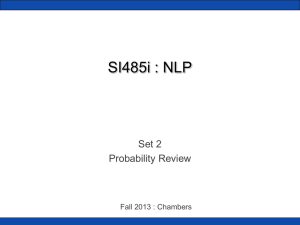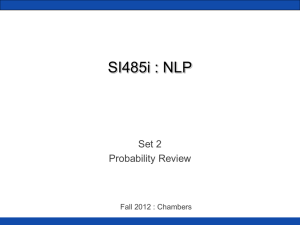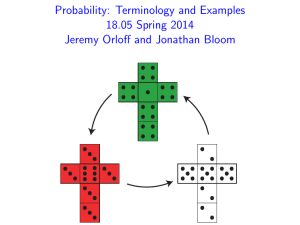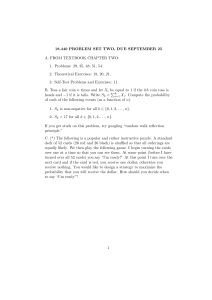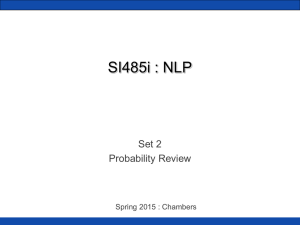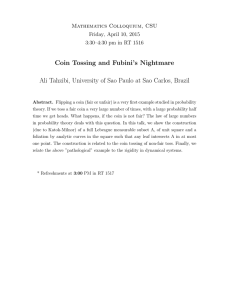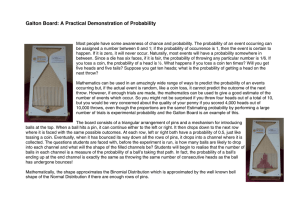Document 13436888
advertisement
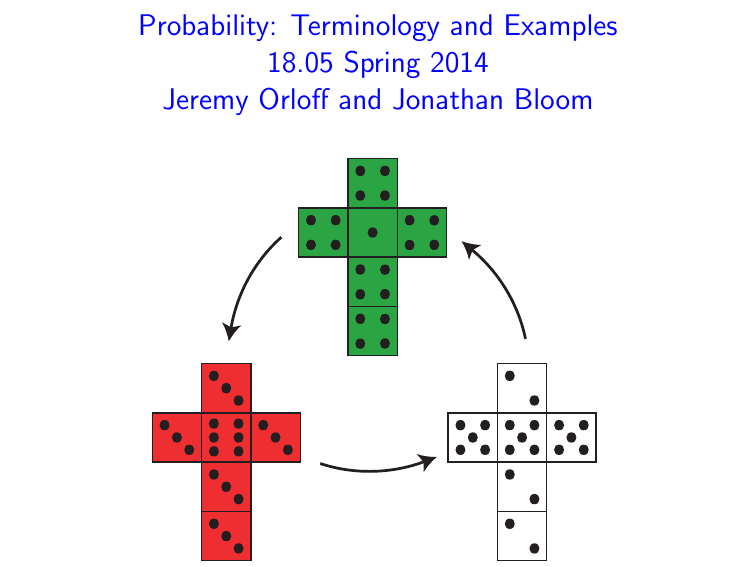
Probability: Terminology and Examples
18.05 Spring 2014
Jeremy Orloff and Jonathan Bloom
Discussion Boards
April 22, 2014
2 / 22
Board Question
Deck of 52 cards
13 ranks: 2, 3, . . . , 9, 10, J, Q, K, A
4 suits: ♥, ♠, ♦, ♣,
Poker hands
Consists of 5 cards
A one-pair hand consists of two cards having one rank and the
remaining three cards having three other rank
Example: {2♥, 2♠, 5♥, 8♣, K♦}
Question
a) How many different 5 card hands have exactly one pair?
Hint: practice with how many 2 card hands have exactly one pair.
Hint for hint: use the rule of product.
b) What is the probability of getting a one pair poker hand?
April 22, 2014
3 / 22
Clicker Test
Set your clicker channel to 41.
Do you have your clicker with you?
No = 0
Yes = 1
April 22, 2014
4 / 22
Probability Cast
Introduced so far
Experiment: a repeatable procedure
Sample space: set of all possible outcomes S (or Ω).
Event: a subset of the sample space.
Probability function, P(ω): gives the probability for
each outcome ω ∈ S
1. Probability is between 0 and 1
2. Total probability of all possible outcomes is 1.
April 22, 2014
5 / 22
Example (from the reading)
Experiment: toss a fair coin, report heads or tails.
Sample space: Ω = {H, T }.
Probability function: P(H) = .5, P(T ) = .5.
Use tables:
Outcomes
H
Probability
1/2
T
1/2
(Tables can really help in complicated examples)
April 22, 2014
6 / 22
Discrete sample space
Discrete = listable
Examples:
{a, b, c, d} (finite)
{0, 1, 2, . . . } (infinite)
April 22, 2014
7 / 22
Events
Events are sets:
Can describe in words
Can describe in notation
Can describe with Venn diagrams
Experiment: toss a coin 3 times.
Event:
You get 2 or more heads = { HHH, HHT, HTH, THH}
April 22, 2014
8 / 22
CQ: Events, sets and words
Experiment: toss a coin 3 times.
Which of following equals the event “exactly two heads”?
A = {THH, HTH, HHT , HHH}
B = {THH, HTH, HHT }
C = {HTH, THH}
(1) A
(2) B
(3) C
(4) A or B
April 22, 2014
9 / 22
CQ: Events, sets and words
Experiment: toss a coin 3 times.
Which of the following describes the event
{THH, HTH, HHT }?
(1)
(2)
(3)
(4)
“exactly one head”
“exactly one tail”
“at most one tail”
none of the above
April 22, 2014
10 / 22
CQ: Events, sets and words
Experiment: toss a coin 3 times.
The events “exactly 2 heads” and “exactly 2 tails” are
disjoint.
(1) True
(2) False
April 22, 2014
11 / 22
CQ: Events, sets and words
Experiment: toss a coin 3 times.
The event “at least 2 heads” implies the event “exactly
two heads”.
(1) True
(2) False
April 22, 2014
12 / 22
Probability rules in mathematical notation
Sample space: S = {ω1 , ω2 , . . . , ωn }
Outcome: ω ∈ S
Probability between 0 and 1:
Total probability is 1:
Event A: P(A)
April 22, 2014
13 / 22
Probability and set operations on events
Rule 1. Complements. .
Rule 2. Disjoint events.
Rule 3. Inclusion-exclusion principle.
Ac
A
Ω = A ∪ Ac , no overlap
L
R
L ∪ R, no overlap
L
R
L ∪ R, overlap = L ∩ R
April 22, 2014
14 / 22
Concept question
Class has 50 students
20 male (M), 25 brown-eyed (B)
For a randomly chosen student what is the range of
possible values for p = P(M ∪ B)?
(a) p ≤ .4
(b) .4 ≤ p ≤ .5
(c) .4 ≤ p ≤ .9
(d) .5 ≤ p ≤ .9
(e) .5 ≤ p
April 22, 2014
15 / 22
Table Question
Experiment:
1) Roll your 20-sided die.
2) Check if all rolls at your table are distinct.
Repeat the experiment five times and record the results.
April 22, 2014
16 / 22
Table Question
Experiment:
1) Roll your 20-sided die.
2) Check if all rolls at your table are distinct.
Repeat the experiment five times and record the results.
For this experiment, how would you define the sample
space, probability function, and event?
Compute the exact probability that all rolls are distinct.
April 22, 2014
16 / 22
Concept Question
Lucky Larry has a coin that you’re quite sure is not fair.
He will flip the coin twice
It’s your job to bet whether the outcomes will be the
same (HH, TT) or different (HT, TH).
Which should you choose?
1. Same
2. Different
3. It doesn’t matter, same and different are equally likely
April 22, 2014
17 / 22
Board Question
Lucky Larry has a coin that you’re quite sure is not fair.
He will flip the coin twice
It’s your job to bet whether the outcomes will be the
same (HH, TT) or different (HT, TH).
Which should you choose?
1. Same
2. Different
3. Doesn’t matter
Question: Let p be the probability of heads and use
probability to answer the question.
(If you don’t see the symbolic algebra try p = .2, p=.5)
April 22, 2014
18 / 22
Jon’s dice
Jon has three six-sided dice with unusual numbering.
A game consists of two players each choosing a die. They
roll once and the highest number wins.
Which die would you choose?
April 22, 2014
19 / 22
Board Question
Compute the exact probability of red beating white.
1) For red and white dice make the probability table.
2) Make a prob. table for the product sample space of red
and white.
3) What is the probability that red beats white?
April 22, 2014
20 / 22
Answer to board question
For each die we have a probability table
Outcomes
Probability
Red die
3
6
5/6 1/6
Outcomes
Probability
White die
2
5
1/2 1/2
For both together we get a 2 × 2 probability table
Red
3
6
White
2
5
5/12 5/12
1/12 1/12
The red table entries are those where red beats white. Totalling the
probability we get P(red beats white) = 7/12.
April 22, 2014
21 / 22
Concept Question
We saw red is better than white.
We’ll tell you that white is better than green.
So red is better than white is better than green.
Is red better than green?
April 22, 2014
22 / 22
0,72SHQ&RXUVH:DUH
KWWSRFZPLWHGX
,QWURGXFWLRQWR3UREDELOLW\DQG6WDWLVWLFV
6SULQJ
)RULQIRUPDWLRQDERXWFLWLQJWKHVHPDWHULDOVRURXU7HUPVRI8VHYLVLWKWWSRFZPLWHGXWHUPV


